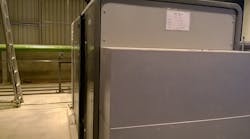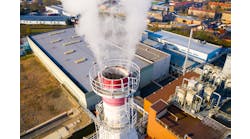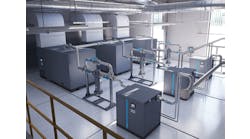Many plants rely on instrument air. This is very clean and filtered compressed air usually specified to stay dry at around -40°C (or sometimes less). It is used for instruments, control and pneumatic systems that typically operate between 6 and 11 Barg. An instrument air supply package generally consists of one or two air compressors, filters and dryers. Such a package plays a vital role in the operation, control, safety and reliability of the plant. This article discusses air compressors, air dryers and their accessories and auxiliaries.
Instrument air as a motive force can provide many benefits. An air-operated system can offer a better power-to-weight ratio than an electrical one. Generally, air-operated devices are more compact, simpler, safer and probably more reliable compared to electrical alternatives. However, pneumatic systems only are around 25–40% as efficient as their electrical counterparts.
Air-operated systems and devices usually serve in applications where other options cannot be used, e.g., due to area classification, or where they can offer significant cost, operational, safety or reliability advantages.
Unfortunately, experience indicates that many plants suffer, at least at first, from undersized instrument air systems. This usually becomes clear at start-up or during the initial period of operation. Avoiding such a problem hinges upon proper analysis of demand during design and sizing.
In some other plants, careless design or risky connections undermine the reliability of instrument air systems, leading, e.g., to uncontrolled leakage, and dirt and debris in the network. Components of the system, connections, and consumers of air require careful checking.
Air Compressors
These units fall into two general categories: positive displacement compressors and dynamic compressors. Positive displacement compressors can be further separated into reciprocating and rotary machines. Typical reciprocating compressors include piston and diaphragm types while rotary compressors are available in many different designs such as sliding vane and dry screw. The most widely used type of positive displacement unit for air services is the dry screw compressor. Dynamic compressors come in two types: centrifugal and axial machines, with centrifugal machines in a conventional configuration or in an integrally geared compressor train most widely used.
Like the advice that Amin Almasi provides? You can access a whole slew of articles written by him in "Equipment Insights."
It is difficult to give general advice on selection of air compressors. However, for instrument air systems, an inherently dry compression mechanism is a clear requirement. In other words, avoid compressors that add oil or other liquids to the compressed air. While non-dry (wet) compressors have been used in many air applications, these compressors pose great risks to instrument air systems.
Many small applications suit dry-type reciprocating compressors (dry piston compressors). These machines provide oil-free operation by using, for instance, low-friction polytetrafluoroethylene for wearing parts that come in contact with the airstream.
As a very rough guide, choose a single-stage compressor for pressures of 3.5 Barg or less and a multistage compressor for pressures of around 4.5 Barg or more. A two-stage piston compressor uses less power than a single-stage unit for equivalent output. Piston compressors come in a wide variety of capacities and pressures. Diaphragm compressors use a flexible diaphragm to compress air; therefore, these machines avoid contact between the reciprocating mechanism and the compressed air. However, they are restricted to light-duty, low-capacity and low-pressure applications where economy is a factor. A water-cooled unit generally is more efficient than an air-cooled one; it has lower power consumption but higher initial cost.
Sliding vane compressors have handled limited applications for air services. In such units, vanes mounted eccentrically in a cylindrical rotor are free to slide in and out of slots. As the rotor turns, the space between the compressor casing and the vanes decreases, compressing the air. These are compact units, well suited for direct connection to an electric motor. However, their efficiency usually is less than that of an equivalent piston unit. They are best used in services requiring small, low-capacity compressors, generally in the range of up to 300 m3/h and 4.5 Barg, where their low costs and simple configuration may offer some advantages. In recent years, sliding vane compressors have become less popular for air systems.
In dry screw compressors, a pair of close clearance screw (helical lobe) rotors turn together. As air enters the inlet, the rotation of the lobes causes the cavity in which air is trapped to become smaller and smaller, increasing the pressure. Capacity is varied by adjusting the speed of the driving motor, reducing the amount of inlet air, or returning a portion of the compressed air discharged back into the inlet (suction). The outlet piping should contain one or two check valves to prevent air from escaping through the compressor after the unit has stopped. Because of the rotary operation, discharge is almost continuous. This type of compressor is best suited for applications with capacities of up to 30,000 m3/h and discharge pressure between 6 and 18 Barg. Dry screw compressors have been very popular for air compression systems because of their inherent dry compression mechanism, good reliability, economy and overall excellent operation.
Centrifugal compressors have been popular for air compressor systems; in these machines, rotating blades or impellers impart velocity (energy) to the air, which is converted to increased pressure inside the casing. This type of compressor is best suited for high rates, say, capacities of 700 m3/h to 300,000 m3/h. Centrifugal compressors are smaller than similar reciprocating units but use more power. The air delivered is oil free. Such units are considered as the first option for large plants and high-reliability air systems because they offer the greatest reliability and availability among the many different types of air compressors. Some operating companies specify and use only centrifugal compressors for critical air systems.
Dry Screw Compressors
These machines cover very broad ranges of capacity and pressure; they are widely used for medium-size applications but also handle some small services and large applications. Indeed, dry screw compressors are the most popular machines in air and instrument air services. Therefore, from here on, we’ll focus on this type of compressor.
Dry screw compressors work on a displacement principle — male and female screw rotors move toward each other while the volume between them and the housing decreases. The pressure ratio of a screw depends on the length and profile of the screw and the form and design of discharge port. The screw system has no valves, so there are no mechanical forces to create imbalance. It can operate at relatively high shaft speed (say, 6,000 rpm or more) and combine a large flow rate with small exterior dimensions. Dry-type screw rotors are not in contact with each other. They are separated by tiny (a few or several micron) clearances. Therefore, high-performance operation requires relatively high speed. Screw rotors are driven by a timing gear system. Most often, conventional induction electric motors (1,500 or 3,000 rpm) drive the compressors, although other drivers, such as various types of engines, may be used.
Many air compressor packages use a two-stage oil-free rotary compressor to achieve a compressor discharge pressure in the range of 9–15 Barg. The packages come with auxiliary equipment such as air filters, intercooler, after-cooler, oil-cooler, enclosure, dampeners, oil filtration and lubrication system, electrical controls, etc. Lubrication oil is needed for the bearings. However, seals, which separate the air compression section from the bearings, prevent lubricant from reaching the inside of the machine where air is compressed. Many applications opt for “1+1”, “2+1” or “3+1” compressor configurations, i.e., one or more units running (in parallel for multiple machines) plus a spare.
A dry screw air compressor usually should be provided with vibration probes and other sensors suitable for full condition monitoring. As an example, each bearing should be equipped with X-Y vibration probes. At least one keyphasor and one axial vibration probe should be included for each shaft. In addition, bearings and critical locations need proper temperature sensors (i.e., resistance temperature detectors). Another important consideration is monitoring using operating conditions such as trends of developed capacity, pressure, etc., to evaluate the health and performance of the units.
Capacity Control
In a part-load scheme or operation using capacity control, the screw air compressor remains continuously powered. When the demand for compressed air is satisfied or reduced, a capacity control device is activated. This lowers the number of start/stop cycles for electric motors, significantly improving equipment service life with a tiny increase in the operating cost. Such a scheme nearly always is utilized to boost the reliability and availability of air compressor packages and also to provide operational flexibility.
Many different methods allow operation at part-load and capacity control of an air compressor. A well-known method is the bypass loop (recycle line). Here, a portion of discharge air, often air that has gone through the after-cooler, is routed back to the suction. Different sizing guidelines have been proposed for the valve and line — the most common ones are 100% and 50%.
Variable speed drives (VSDs) often make sense for air compressor services needing excellent operational flexibility and capacity control to cover a wide range of capacity/pressure. Due to the limited adjustment in compressor power consumption relative to compressed-air output capacity, any form of capacity control usually is inefficient compared to VSDs. However, VSDs usually are restricted to relatively large applications or special services that can justify their high costs.
Air Dryers
The air dryer directly impacts the performance and operation of an air supply package. Also, the efficiency of an air compressor can depend upon the air dryer. While different dryer types are available, desiccant-based systems commonly handle air drying. These systems usually use external heat, regenerative-type dual-tower dryers; one tower is online while the other is regenerating the desiccant, which usually is activated alumina. As a very rough indication, the regeneration cycle is approximately 3–4 h, the heating time usually is around 2 h, and the cooling time most often is about 1.5 h. Therefore, a regeneration cycle typically takes 7–8 h.
To maintain the regeneration cycle, the purge air rate usually is around 10–15% of the total package air flow. Compressor sizing always should consider this extra air flow. As a rough indication, air capacity should include a 20–30% margin to account for package losses, purge air, etc.
Two full-sized units (2×100%) should be used for all critical equipment in the dryer package, for example, 2×100% filters, 2×100% dryer towers, 2×100% heaters, etc. The switching to a standby component (filter, tower, heater, etc.) should be automatic. The design, manufacturing and assembling should guarantee the continued operation of an air dryer package in the event of failure of a component, e.g., heater, blower, etc. Many different configurations exist for switching systems. Automatic switchover between beds most often is timer-based with manual change also possible. Any dryer package should include both pre-filter and after-filter systems. In addition, verifying and monitoring the operation of a dryer system requires a moisture analyzer and other sensors.
Case Study
Let’s now look at the details of a two-stage dry screw compressor to supply instrument air for a chemical plant. The compressor is a vertically split machine with foot mounting. The package is sized for the rated capacity of 810 m3/h and rated discharge pressure of 9 Barg. The driver is an induction electric motor with a power rating of 180 kW and nominal speed of 1,500 rpm. The compressor has two screws with speeds of 10,571 rpm and 6,796 rpm; these are driven by a specially designed timing gear system. The maximum and minimum air discharge pressures of the air compressor are approximately 10.5 Barg and around 5 Barg, respectively. The compressor casing is designed for higher pressure, in this case a maximum allowable pressure of 20 Barg. The compressor casing is cast steel with a special coating; screw rotors are made from special alloy steels and have the same coating. All other parts and piping are fabricated from stainless steel. Two compressors are provided, one operating and the other on standby.
The air dryer selected for this application is a desiccant-based system that uses external heat, regenerative-type dual-tower dryers. Each dryer is designed for 12 Barg maximum operating pressure and is protected by a pressure relief valve. Pressure drop in the package is less than 0.7 Barg; therefore, considering all other losses, the rated output pressure of the package is around 8 Barg. The dryer and its piping are fabricated from stainless steel. One tower is online while the other is on standby; each contains around 300 kg of activated alumina. The system employs timer-based automatic switchover of the towers (from online to regeneration and vice versa). The package also includes pre-filter after-filter systems.
AMIN ALMASI is a mechanical consultant based in Sydney, Australia. Email him at [email protected]




